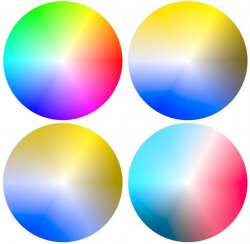I'm a science geek, and of course have a particular interest in color blindness, so I hope you won't mind if I share some facts and figures.
--- Scientific facts ---
* Most color blindness is
congenital (you are born with it), as opposed to the less common
acquired form.
* Your retina contains rods that react to light levels, and three types of cones that react to color. When all three types of cones work normally, you are a
trichromat ("3 colors"). When only two types work, you are a
dichromat ("2 colors"). When only one type works, you are a
monochromat ("1 color").
* The most common form of color blindness is
red-green color blindness, which causes difficulty in distinguishing red, green, sometimes yellow, and colors based on them, such as brown and orange. It comes in two forms, which are about equally prevalent:
Protanopia - can't sense red, or can't sense it well. The "L" cones are faulty.
Deuteranopia - can't sense green, or can't sense it well. The "M" cones are faulty.
* A less-common form is
blue-yellow color blindness (
tritanopia). Tritanopes do not sense blue, or do not sense it well, and have trouble distinguishing blue from yellow. Their "S" cones are faulty.
* Rarest of all is
monochromacy, a complete lack of color vision, which affects maybe 3 in a million.
* Human color perception is a complicated subject. Many factors besides the basic functions of rods and cones affect our perception, and there are variations from person to person.
* Occasionally, but very rarely, a person is color blind in only one eye. Such people make ideal research subjects.



